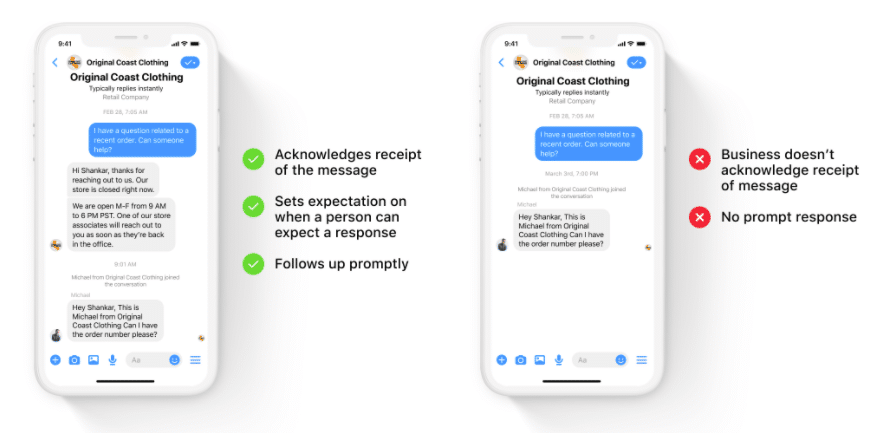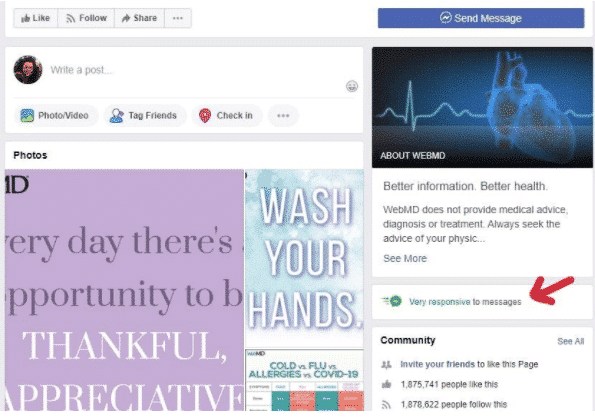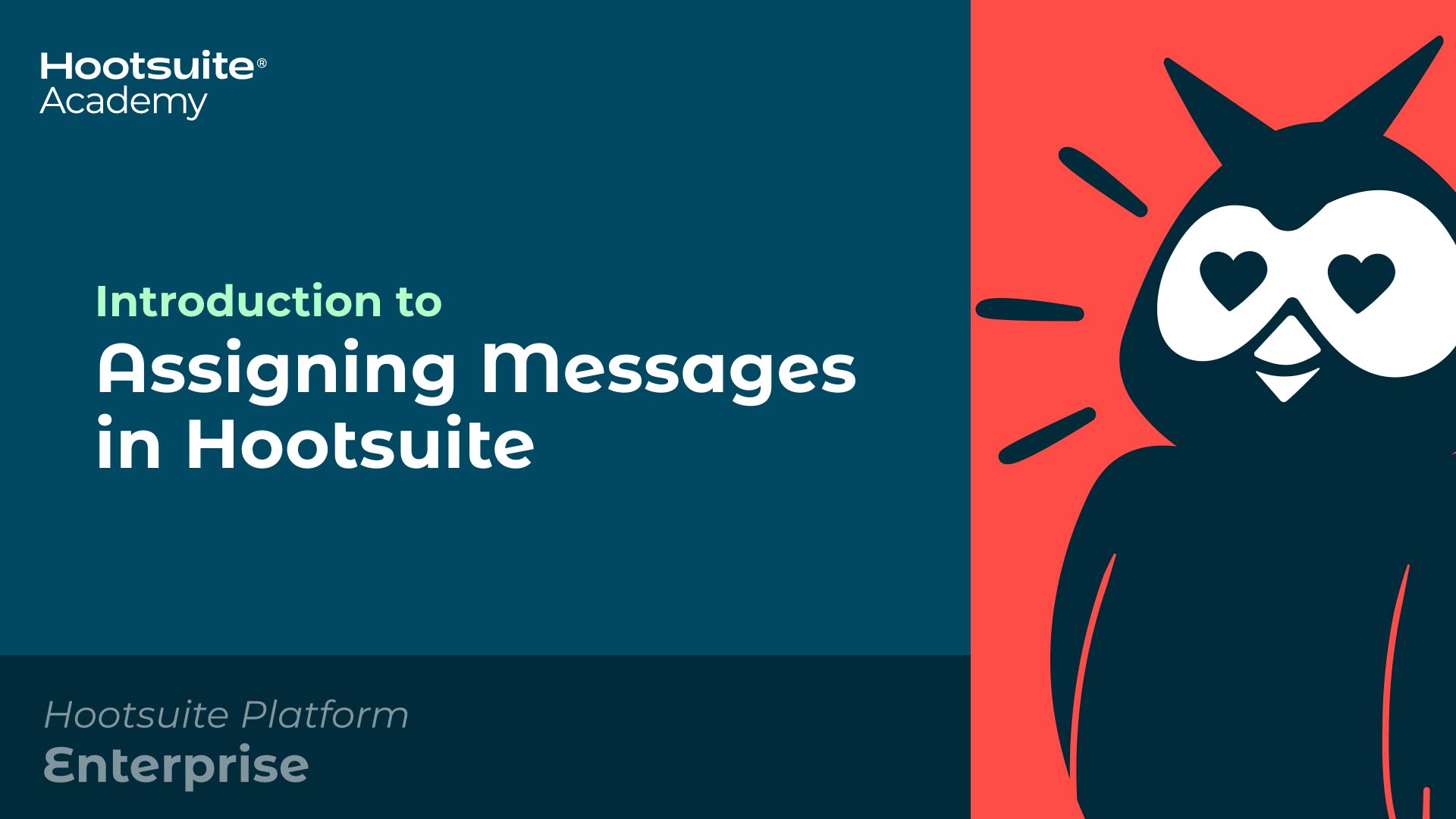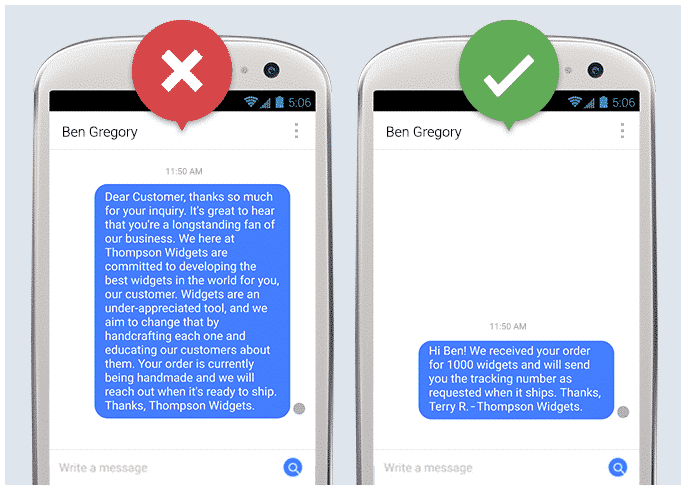Facebook Messenger Etiquette for Brands: 10 Things NOT to Do
If you’re not using Facebook Messenger to engage customers and prospects, you’re missing out. Two-thirds of consumers prefer to use messaging apps to connect with brands.
Given that Facebook had nearly 2.5 billion active monthly users in Q4 2019, Facebook Messenger is the place to be if you want to distinguish and grow your business.
Consider these numbers:
- In 2017, there were 70 million businesses with a Facebook presence.
- According to a recent survey, 83% of woman-owned small and midsize businesses are using Facebook Messenger to engage customers.
- But in total, just 31% of businesses are using Facebook Messenger.
Some brands are using Facebook Messenger to drive loyalty and sales. But millions more aren’t. If you want to set your brand apart, this is a prime opportunity.
In this post, we’ll explain how Facebook Messenger can benefit your business—and the rules of etiquette for this important channel.
Bonus: Download a free guide that teaches you how to turn Facebook traffic into sales in four simple steps using Hootsuite.
Why use Facebook Messenger for business?
Users see Facebook Messenger as a direct, private line to the heart of a business. It’s also a great way to get a quick, personal response. In this setting, your business can serve people well, build relationships, complete transactions, and set the stage for future sales.
With Facebook Messenger, you can not only engage consumers through personal messaging, but also buy ads to draw consumers in or reengage people who’ve already contacted you. Currently, there are two types of Facebook Messenger ads:
- Click-to-Messenger ads—A call to action appears on the brand’s Facebook page. When users click through to Messenger, a conversation starter appears. It usually contains an offer that encourages the user to take a next step.
- Sponsored message—A sponsored message appears in the Messenger inbox of a user who has interacted with the brand’s Facebook page. These ads can take various forms (see our complete guide to advertising on Facebook).
By making the most of Facebook Messenger through great advertising and customer service, you’ll build a loyal brand community that’s receptive to your offers and more inclined to spend.
10 etiquette mistakes to avoid on Facebook Messenger
On Facebook Messenger, you’ll never get a second chance to make a first impression. To earn a consumer’s trust, you’ll need to demonstrate sincerity, care, and respect. For starters, you’ll want to avoid these 10 etiquette mistakes.
1. Not having an automatic greeting or response
If someone sends you a message, don’t greet them with silence. Friendly text should appear as soon as the message thread is opened. Use instant replies to acknowledge receipt of a message, say “thanks,” and set expectations for how soon a live person might respond.
You can personalize your greeting by including the user’s name. You can also provide contact information so the user can reach you on another channel.
For a step-by-step guide to creating instant replies, read our Facebook Messenger complete guide for business.

Source: Facebook for developers
2. Taking too long to reply (or not replying at all)
Having a question or request go unanswered by a business is disappointing. And for many consumers, it’s a deal breaker.
You’ll need to act fast once a user sends a message and receives an instant response.
One thing to keep in mind: as soon as you open a message in Facebook Messenger, the sender can see that it’s been viewed. Don’t open messages till you’re ready to respond, but make sure you do so within a few hours.
Businesses that have a response rate above 90% and response times under 15 minutes can earn a “very responsive” badge. It’s a great way to show your brand is caring and customer centered.
To earn the badge, start by following these Facebook-recommended practices.

If no one is available to respond right away, schedule an automated away message for the time period your Facebook Messenger will be closed for business.
(Or, you could use Hootsuite Inbox to assign messages to a teammate who is available. The video below shows how.)

3. Not providing context
It’s important to send timely responses, but it’s also important that your messages reflect:
- What led the user to contact you
- Whether they’ve interacted with the brand page or purchased before
- Whether the user’s message is related to an earlier exchange
Any message that lacks context might seem tone deaf. It could also create unnecessary friction for someone who’s trying to get help or complete a purchase.
With Hootsuite Inbox, each new message appears in a user-specific thread. There, you can see past activity and reference it in future messages. You can also click the user’s name at the top of the thread to access the customer context panel for more information. With an enterprise plan, you’ll see notes you’ve added and Facebook Messenger conversations you’ve had over the past six months.

4. Using sarcasm or irony
Using sarcasm and irony on social media can be dangerous. How many times have you seen people misinterpret and take offence at a tongue-in-cheek remark?
If you’re not communicating in a straightforward way, you might never know you’ve lost someone’s business (or any hope of getting it).
Can edgier brands get away with a little more attitude? Not in Facebook Messenger. If someone is reaching out with a question or suggestion, a snarky comment suggests you’re not taking the person or their concerns seriously.
5. Messaging too frequently
On March 4, Facebook changed its 24-hour response policy. Businesses now have 24 hours to send messages (by human or bot) in response to certain user actions, with no additional responses allowed afterward.
User actions that start the 24-hour countdown include:
- Sending a message to a brand page
- Clicking a call-to-action-button within a Messenger conversation
- Clicking on a Click-to-Messenger ad and starting a conversation
- Starting a conversation with the brand page via plugin
- Reacting to a message
But no matter how or why a user reaches out to you, it’s not an invitation to flood their inbox. Limit your response(s), and make sure they’re relevant to the initial message.
After the initial 24-hour period, you can send event reminders and order and account updates using streamlined message tags. You can also send sponsored messages to re-engage customers and prospects.
Order status updates are always appreciated. So is the occasional flash sale. But don’t inundate people with offers. Too many Facebook Messenger notifications will eat up brand equity fast.
6. Sending sloppy, error-filled messages
Nothing says “uncaring” like a poorly written message. Friends may forgive grammar, punctuation, and spelling errors, but customers and prospects won’t cut you any slack.
Before you hit “send,” take a minute to check for typos, missing words, misplaced punctuation, etc. Try tightening up the language. Make sure you’ve covered all the bases in your response. The person on the receiving end will appreciate the effort.
Bonus: Download a free guide that teaches you how to turn Facebook traffic into sales in four simple steps using Hootsuite.
Get the free guide right now!7. Writing long paragraphs
Think of the last time you searched for a simple answer but encountered a giant wall of text instead. You had to comb through to find what you needed. Frustrating, right?
The last thing you want to do is give your customers and prospects the same experience.

Source: Facebook for business
Keep your messages on point and easy to digest by limiting them to two or three short sentences. If the user’s question or problem is more complex, you might want to continue the conversation on another channel (phone, email, or live chat).
8. Letting bots do all the work
A Facebook Messenger bot can be a great business tool. But most of Facebook’s 6 million advertisers aren’t seizing the opportunity. Today, there are only 300,000 active Messenger bots.
Bots can acknowledge users’ messages, gather input, and answer basic questions. They can also complete simple tasks—everything from checking flight statuses to recommending products.
You can use quick replies, for example, to ask for a user’s product preferences or contact information. Once the user provides the requested information, that action prompts a new message, and the quick reply request disappears.

Source: Facebook for developers
Here are Original Coast Clothing’s quick replies in action:

Source: Facebook for developers
Don’t rely too heavily on bots, or you’ll irritate consumers who prefer to deal with real people. If a question or problem is too complex for bots to handle, they should “know” to stand down. If a live person isn’t available to connect, direct users to a different channel so they can get the help they need.
To learn more about how to create Facebook bots and how leading brands are using them, check out our complete guide to using Facebook Messenger bots for business.
9. Forwarding a message to a third party
People use Facebook Messenger, rather than posting on a brand’s Facebook page, because the platform is private. Forwarding a user’s messages to a third party would be perceived as a breach of trust.
If you need to involve a third party to escalate a customer service issue, for example, you should ask for express permission to forward the message thread. Otherwise, provide a phone number and/or email address the customer can use to connect with the third party directly.
10. Not saying goodbye
If you assume a Facebook Messenger conversation has ended and you fall silent without saying goodbye, you could leave the consumer feeling neglected or snubbed. This wouldn’t be a good look for your brand or a smart move for your business.
It’s important to bring closure to every exchange. Always begin with some version of “Is there anything else I can help you with today?” You’ll never know what other loyalty-building or sales-driving opportunities await.
Use Hootsuite Inbox to engage with your customers and respond to messages from all your social channels in one place. You’ll get full context around each message, so you can respond efficiently and focus on strengthening your relationships with customers.
The post Facebook Messenger Etiquette for Brands: 10 Things NOT to Do appeared first on Hootsuite Social Media Management.
Categories
- 60% of the time… (1)
- A/B Testing (2)
- Ad placements (3)
- adops (4)
- adops vs sales (5)
- AdParlor 101 (43)
- adx (1)
- algorithm (1)
- Analysis (9)
- Apple (1)
- Audience (1)
- Augmented Reality (1)
- authenticity (1)
- Automation (1)
- Back to School (1)
- best practices (2)
- brand voice (1)
- branding (1)
- Build a Blog Community (12)
- Case Study (3)
- celebrate women (1)
- certification (1)
- Collections (1)
- Community (1)
- Conference News (1)
- conferences (1)
- content (1)
- content curation (1)
- content marketing (1)
- contests (1)
- Conversion Lift Test (1)
- Conversion testing (1)
- cost control (2)
- Creative (6)
- crisis (1)
- Curation (1)
- Custom Audience Targeting (4)
- Digital Advertising (2)
- Digital Marketing (6)
- DPA (1)
- Dynamic Ad Creative (1)
- dynamic product ads (1)
- E-Commerce (1)
- eCommerce (2)
- Ecosystem (1)
- email marketing (3)
- employee advocacy program (1)
- employee advocates (1)
- engineers (1)
- event marketing (1)
- event marketing strategy (1)
- events (1)
- Experiments (21)
- F8 (2)
- Facebook (64)
- Facebook Ad Split Testing (1)
- facebook ads (18)
- Facebook Ads How To (1)
- Facebook Advertising (30)
- Facebook Audience Network (1)
- Facebook Creative Platform Partners (1)
- facebook marketing (1)
- Facebook Marketing Partners (2)
- Facebook Optimizations (1)
- Facebook Posts (1)
- facebook stories (1)
- Facebook Updates (2)
- Facebook Video Ads (1)
- Facebook Watch (1)
- fbf (11)
- first impression takeover (5)
- fito (5)
- Fluent (1)
- Get Started With Wix Blog (1)
- Google (9)
- Google Ad Products (5)
- Google Analytics (1)
- Guest Post (1)
- Guides (32)
- Halloween (1)
- holiday marketing (1)
- Holiday Season Advertising (7)
- Holiday Shopping Season (4)
- Holiday Video Ads (1)
- holidays (4)
- Hootsuite How-To (3)
- Hootsuite Life (1)
- how to (5)
- How to get Instagram followers (1)
- How to get more Instagram followers (1)
- i don't understand a single thing he is or has been saying (1)
- if you need any proof that we're all just making it up (2)
- Incrementality (1)
- influencer marketing (1)
- Infographic (1)
- Instagram (39)
- Instagram Ads (11)
- Instagram advertising (8)
- Instagram best practices (1)
- Instagram followers (1)
- Instagram Partner (1)
- Instagram Stories (2)
- Instagram tips (1)
- Instagram Video Ads (2)
- invite (1)
- Landing Page (1)
- link shorteners (1)
- LinkedIn (22)
- LinkedIn Ads (2)
- LinkedIn Advertising (2)
- LinkedIn Stats (1)
- LinkedIn Targeting (5)
- Linkedin Usage (1)
- List (1)
- listening (2)
- Lists (3)
- Livestreaming (1)
- look no further than the new yorker store (2)
- lunch (1)
- Mac (1)
- macOS (1)
- Marketing to Millennials (2)
- mental health (1)
- metaverse (1)
- Mobile App Marketing (3)
- Monetizing Pinterest (2)
- Monetizing Social Media (2)
- Monthly Updates (10)
- Mothers Day (1)
- movies for social media managers (1)
- new releases (11)
- News (72)
- News & Events (13)
- no one knows what they're doing (2)
- OnlineShopping (2)
- or ari paparo (1)
- owly shortener (1)
- Paid Media (2)
- People-Based Marketing (3)
- performance marketing (5)
- Pinterest (34)
- Pinterest Ads (11)
- Pinterest Advertising (8)
- Pinterest how to (1)
- Pinterest Tag helper (5)
- Pinterest Targeting (6)
- platform health (1)
- Platform Updates (8)
- Press Release (2)
- product catalog (1)
- Productivity (10)
- Programmatic (3)
- quick work (1)
- Reddit (3)
- Reporting (1)
- Resources (34)
- ROI (1)
- rules (1)
- Seamless shopping (1)
- share of voice (1)
- Shoppable ads (4)
- Skills (28)
- SMB (1)
- SnapChat (28)
- SnapChat Ads (8)
- SnapChat Advertising (5)
- Social (169)
- social ads (1)
- Social Advertising (14)
- social customer service (1)
- Social Fresh Tips (1)
- Social Media (5)
- social media automation (1)
- social media content calendar (1)
- social media for events (1)
- social media management (2)
- Social Media Marketing (49)
- social media monitoring (1)
- Social Media News (4)
- social media statistics (1)
- social media tracking in google analytics (1)
- social media tutorial (2)
- Social Toolkit Podcast (1)
- Social Video (5)
- stories (1)
- Strategy (601)
- terms (1)
- Testing (2)
- there are times ive found myself talking to ari and even though none of the words he is using are new to me (1)
- they've done studies (1)
- this is also true of anytime i have to talk to developers (1)
- tiktok (8)
- tools (1)
- Topics & Trends (3)
- Trend (12)
- Twitter (15)
- Twitter Ads (5)
- Twitter Advertising (4)
- Uncategorised (9)
- Uncategorized (13)
- url shortener (1)
- url shorteners (1)
- vendor (2)
- video (10)
- Video Ads (7)
- Video Advertising (8)
- virtual conference (1)
- we're all just throwing mountains of shit at the wall and hoping the parts that stick don't smell too bad (2)
- web3 (1)
- where you can buy a baby onesie of a dog asking god for his testicles on it (2)
- yes i understand VAST and VPAID (1)
- yes that's the extent of the things i understand (1)
- YouTube (13)
- YouTube Ads (4)
- YouTube Advertising (9)
- YouTube Video Advertising (5)
